Kitchen-living room design 18 sq. m: layout and design options

A studio apartment is perceived by many progressive representatives of the younger generation as a kind of panacea that allows them to make a home not only comfortable, but also original. At the same time, you need to understand that the design of the combined kitchen-living room can turn out to be both successful and very mediocre, therefore it would be wrong to perceive the redevelopment itself as a great way to change everything for the better. For the result to be impressive in a positive direction, it is necessary to carefully consider the concept of the interior and follow the plan without deviating from it.
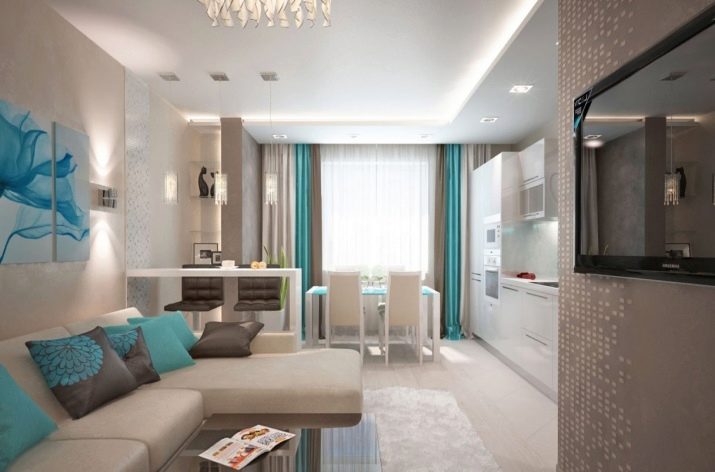
Peculiarities
A combined kitchen-living room is not a priori the optimal solution - it has both advantages and disadvantages. However, if the area of even the connected room is only 18 sq. m, then there is hardly any reason to doubt the expediency of unification - your apartment can be safely called small, and removing walls that take up extra space can be a very reasonable move.
Once the partition was mounted for the simple reason that a separate family had to live in every, even the smallest apartment. Then the wall between the two rooms was justified by practical considerations - while doing kitchen chores with all the accompanying smells and sounds, you could not disturb the rest of the household who are sleeping or just relaxing in the living room. Today, the housing situation for most families looks much better, and in an apartment where the living room and the kitchen together occupy only 18 sq. m, most often one or, at most, two people live.
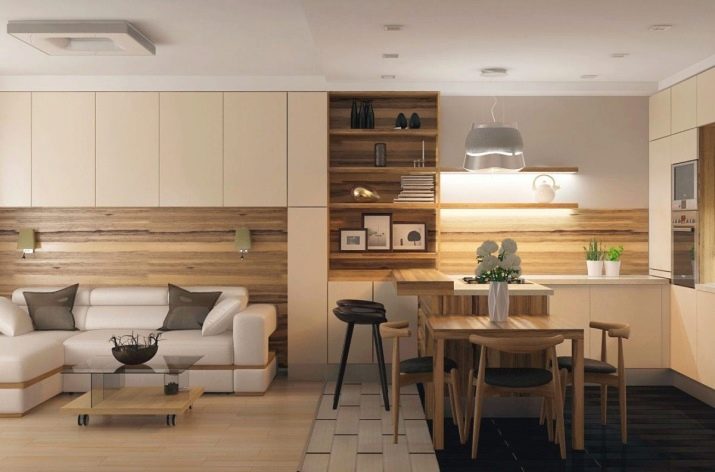
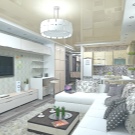
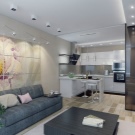

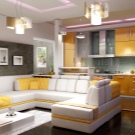
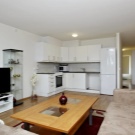
By giving preference to redeveloping your apartment in favor of combining premises, you achieve several positive results at once. First, you get rid of the oppressive cramped conditions, so there are far fewer reasons for claustrophobia in your own home. Secondly, in housing conditions that are not too spoiled by natural lighting, in the absence of a wall, you can use the rays that penetrate all the windows as efficiently as possible, and in fact the abundance of light visually expands the cramped space. Thirdly, now it will be easier for you to invite large companies of guests to your place, because it is advisable to place all those invited in one room, and in your case the whole apartment is.
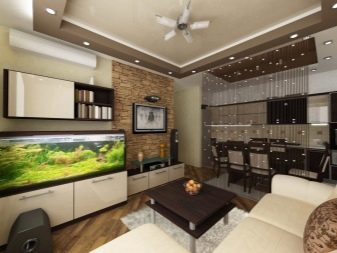
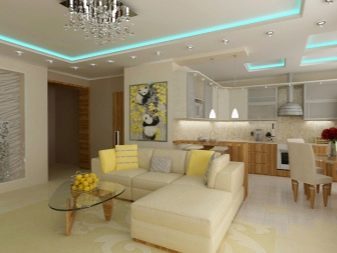
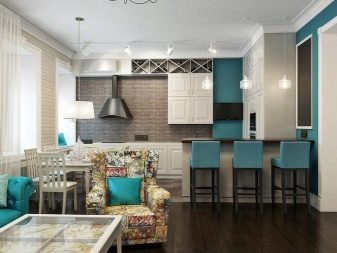
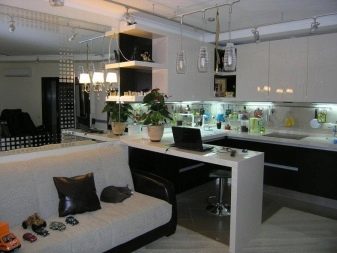
Layout options
A studio room with an approximate size of 3x6 m inevitably implies noticeable limitations for imagination. Ideally, such a combined room should have three main zones: a living room for relaxation, a kitchen area for cooking and a dining area - for receiving guests and everyday breakfasts, lunches and dinners. In small apartments, the last zone is often sacrificed - more precisely, it exists, but so little space has been allocated for it that it is not even perceived as something completely separate.
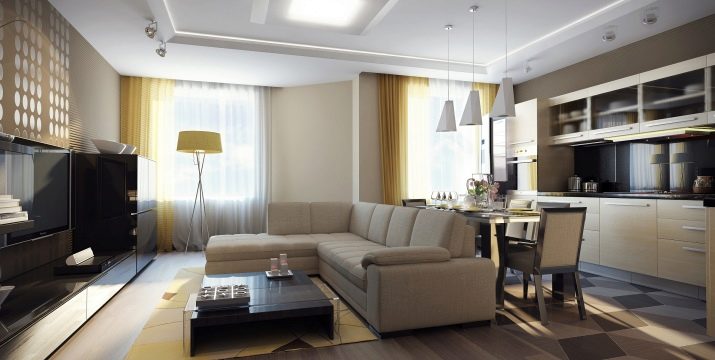



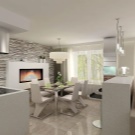

Before demolishing the wall, you must draw up a project for the future room, in which the places for future furniture will be marked. Often, redevelopment is perceived by the owner of square meters as a kind of universal solution that allows you to free up a lot of free space for new furnishings, but, as a rule, such transformations provide for the preservation of the original amount of furniture in favor of increasing the unoccupied area.
In most apartments, which were not originally designed as a studio, the shape of the combined space will be complex - a small square extension of the former kitchen will adjoin the main part, the former living room.
If this is your case, it makes sense not to change the location of the zones - this will greatly simplify the task in terms of transferring communications, and not only in terms of work, but also in terms of bureaucracy.
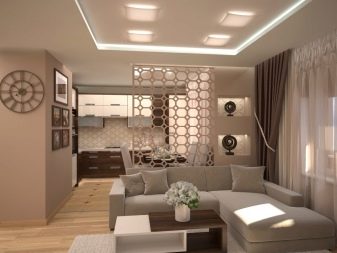
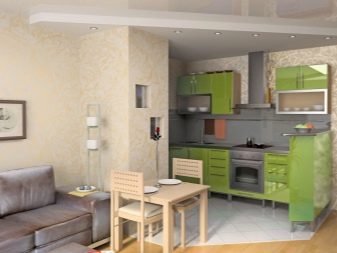
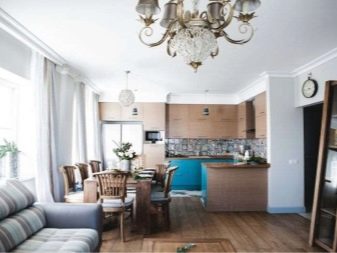
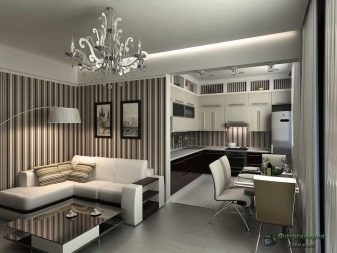
Less often it happens that a studio room is initially square or very similar to a square. In this case, one of the corners is usually allocated under the kitchen, since a comfortable work area should ensure that you, while standing still or taking no more than one step, can reach all the products and tools. Respectively, the living area occupies the opposite corner and space along two walls diverging to the sides of it.

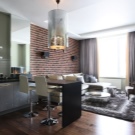
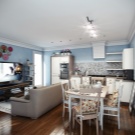
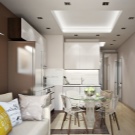
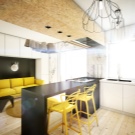
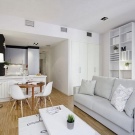
Zoning methods
The combination of two rooms with different functions does not mean their complete fusion together - human nature usually requires that the functional areas still differ from each other. Moreover, even the operational features of the kitchen and the hall directly indicate that they need different finishes and furniture.
It should be said right away that some solid partitions, like the same false wall, are rarely used in a space of 18 square meters... Since you have such a modest square, the freed up space must be used to the maximum advantage, and therefore the following methods of separation should be considered first.



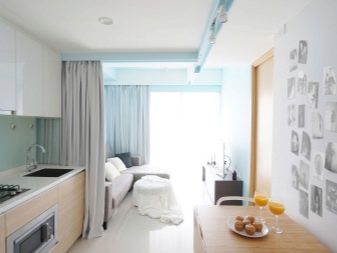
Finish only
If you are very cramped in a limited space, you can completely not separate the kitchen and the living room, and draw the border only conditionally. The kitchen area is constantly faced with high humidity, temperature extremes, splashes of grease and other contaminating food, so its finish must withstand not only all the tests listed, but also cleaning with aggressive chemicals. The living room does not face such tests, it should just be as comfortable and convenient as possible., therefore, they pay more attention to the aesthetics of finishing materials.
Once again, you can emphasize the thin line by raising several squares of the kitchen area to the podium, and even emphasizing this with a multi-level ceiling.
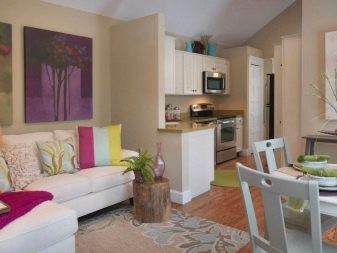
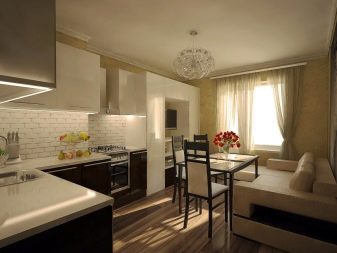
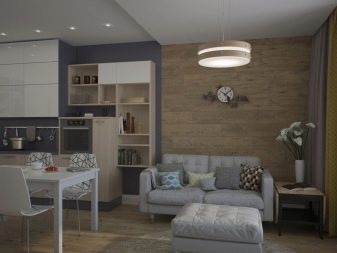
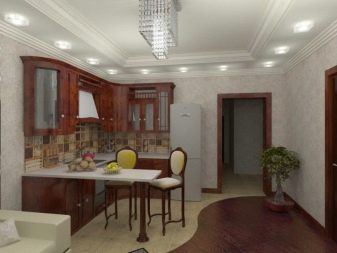
Table or bar
Considering that you will not allocate a full-fledged dining area in any way and it would inevitably have to be organized in one of the two main zones, the selection of the border with the help of a table top seems completely justified. Such an accessory definitely does not interfere with the penetration of light, and you can hardly deny that it is useful. - you want to eat like a human being, at the table. Even if you live alone, friends and relatives may come to visit and need to be seated somewhere.
If you are always at home yourself and do not particularly like to cook, you can limit yourself to the minimum bar counter, to which, if necessary, several people can also sit down.
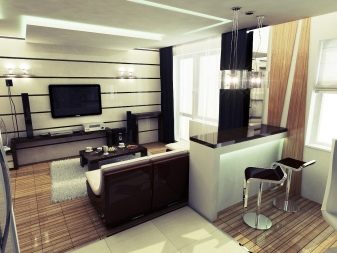
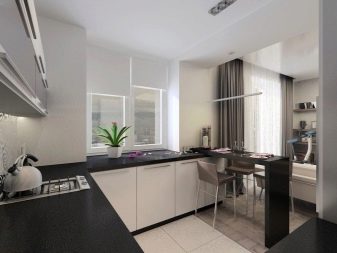
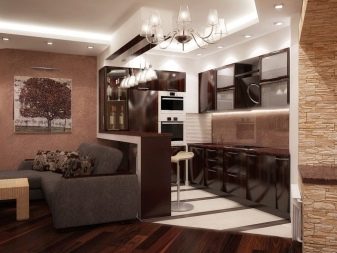
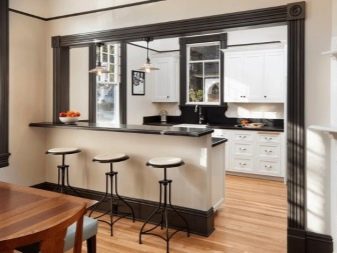
Other functional partitions
One of the most demanded solutions is rightly considered a pass-through rack - it, even without being empty, lets in more light through itself than a blank wall, and at the same time helps to store things or organize a simple exhibition of interesting things. A good alternative is an aquarium or green spaces, both solutions help to relax and cheer up, and vegetation also contributes to an increase in the level of oxygen in the apartment. For those who want to be able to isolate the living room from the smells and sounds of the kitchen, sliding partitions made of plastic or glass, which take up a minimum of space, may be a good option.
... If you only want to "regulate" the lighting, pay attention to the blackout curtains.

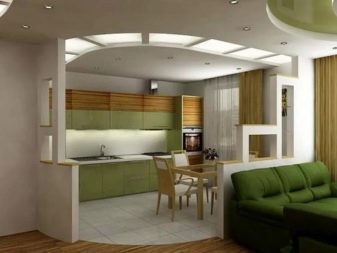
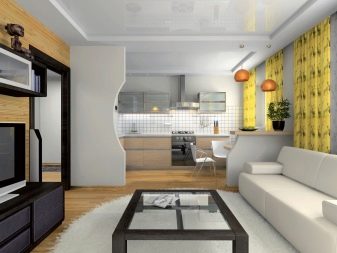
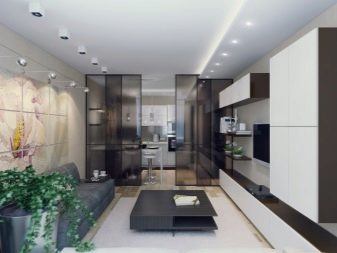
How to choose a style?
Again, the limited space does not give many options for how to decorate a kitchen-living room of such a small size, but still some styles will help to visually expand the walls. You can experiment at your own peril and risk, but most people in a similar situation choose one of the following directions.
Scandinavian style
Well suited for a connected room for two reasons: firstly, it is minimalistic and does not clutter up the space, and secondly, by default it assumes the use of the lightest colors of decoration and furniture, which makes the space seem more spacious. In a hospital room, you will not feel yourself if you add episodic accents of any other color and decorate the interior with large geometric patterns.
Remember that all furnishings should be purely functional, without beautiful knickknacks.
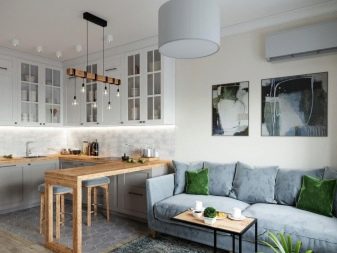
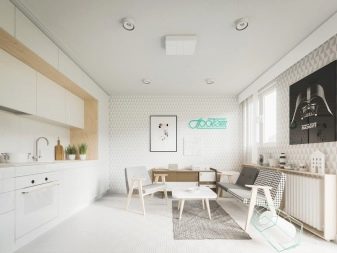
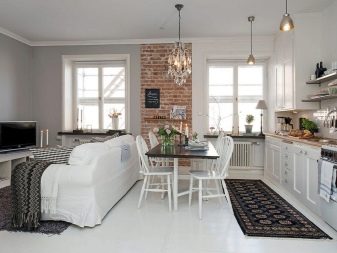

High tech
Suitable for similar conditions for a different reason: he puts great emphasis on modern multifunctional technology, which does not take up much space, but literally can do everything. The color scheme is also predominantly light - white or silver, black blotches are allowed. The most demanded materials are metal and glass.and these are all shiny surfaces, thanks to which you do not feel squeezed in cramped conditions.
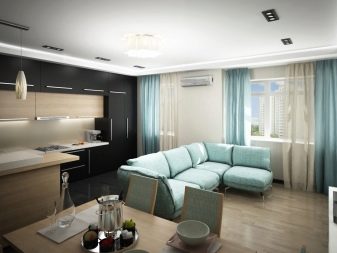

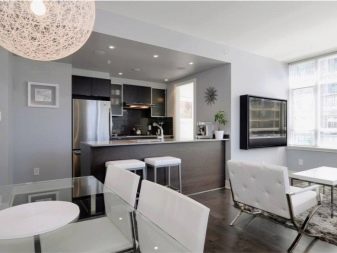
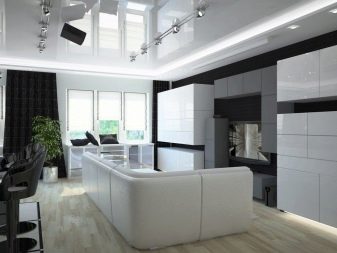
Ecostyle
In contrast to the high-tech described above, he presses on materials of traditional origin - wood, rattan, bamboo, ceramics. A kitchen apron is laid out from tiles that imitate a real stone; live plants in pots look best as decorations. This approach provides an elusive feeling of real home comfort, so you somehow forget about the cramped conditions.
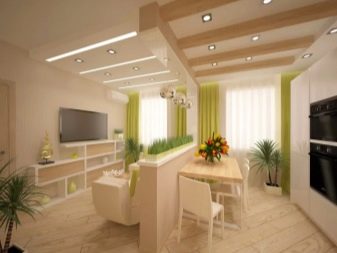
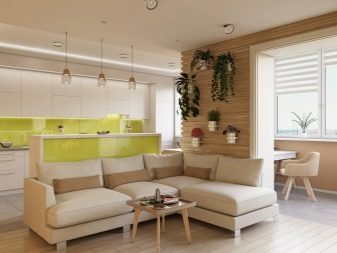
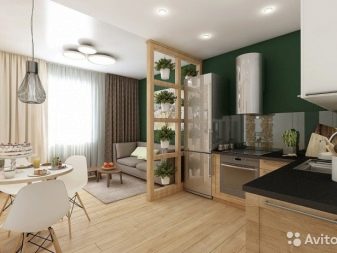
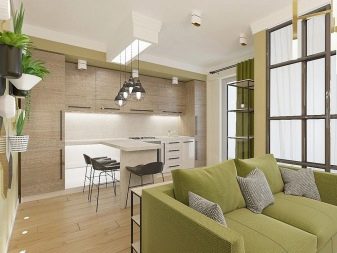
Classic style
It is used with certain reservations - most often in tight spaces it is chosen in a light color scheme, usually consisting of a combination of white and gold. The emphasis is on the high cost of the entire furnishings - wooden items are made only of solid wood, the floor is made of expensive parquet or marble, chandeliers are only crystal, as decoration you can add stucco or columns from the same marble or plaster.Because of this, your small apartment looks very expensive and chic, and here thoughts of a lack of space are simply inappropriate.
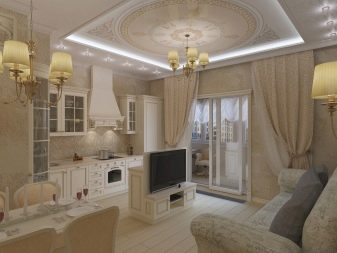

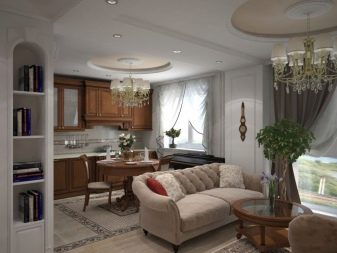
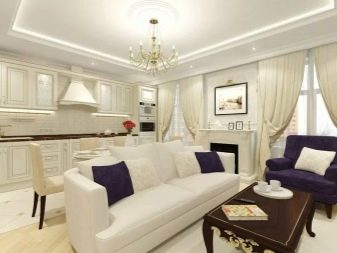
How to choose a color scheme?
The colors of the interior are not always selected purely according to the aesthetic preferences of the owners - for example, in a small room where you need to place a large amount of furniture, it is important to create a visual sense of the breadth of the space, otherwise even those who were not familiar with it will face claustrophobia. Exactly because of this reason a small kitchen-living room is most often finished in light colors - white or pastel with acceptable interspersed with brighter shades. Most of the recommended styles are chosen according to this principle.
It is important that they look organic in the light version.
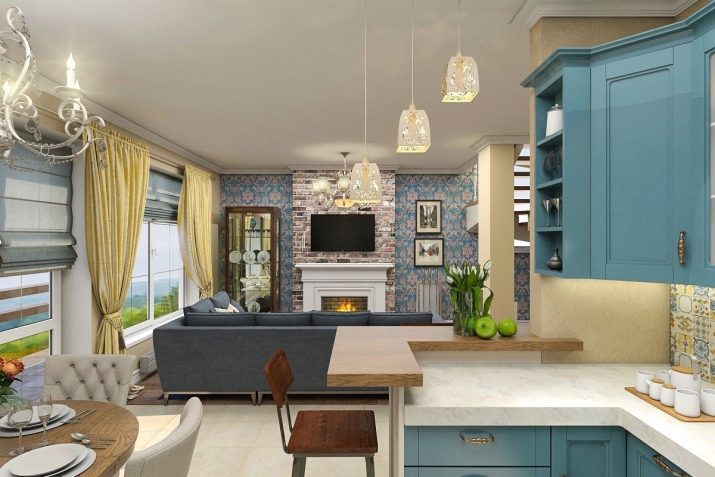
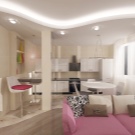

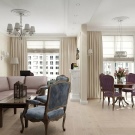
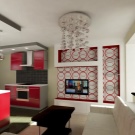
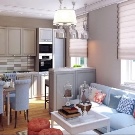
At the same time, no one limits you to purely light shades - you can choose a two- or three-color combination that will turn the studio into a focus of comfort and coziness. At the same time, you should also choose suitable colors based on the degree of natural illumination of the room, and according to the degree of its warming up by the sun's rays. The warm part of the palette is usually chosen in cases where the room clearly lacks the sun. - then decoration and furniture in cold weather raise the mood and add coziness. Likewise, and vice versa - cold colors are relevant where there is an abundance of sunshine in summer; subconscious decoration will help you perceive the visit as a good shelter from the heat. In all these cases, white plays only the role of a background, which has a positive effect on lighting and is neutral in terms of warmth.
It is important to remember that color affects the perception of space, but its influence can be leveled (or enhanced) by the specifics of the chosen pattern.
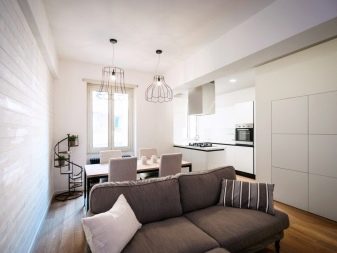

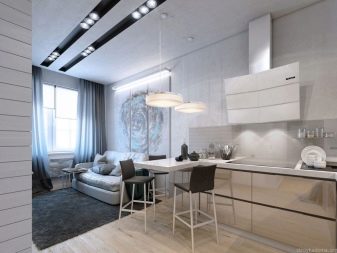
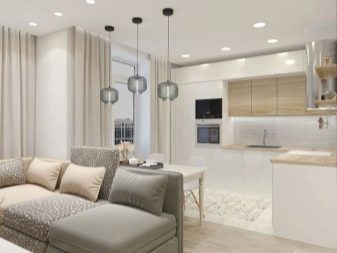
A large pattern inevitably reduces the room, so for 18 squares it makes sense to choose a small and medium-sized pattern, otherwise even a light tone will not help. If you also have trouble with low ceilings, you should give preference to vertically elongated patterns on the walls, as this will visually "lift" the floors.
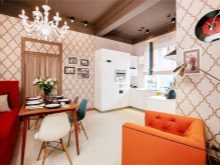
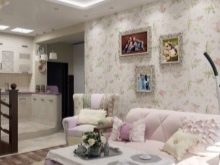
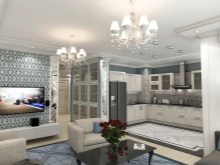
Furnishing tips
When almost all of your apartment fits into a modest area of 18 square meters, furniture should be chosen wisely - it is desirable that it does not take up much space. For this reason, designers usually do not advise choosing wardrobes with traditional swing doors - all furniture of this class should either have sliding doors, or do without such a detail altogether, representing open shelves so as not to interfere with free movement.
In this context the partition between the kitchen and the living room, made in the form of a through rack or bar counter, looks especially practical - having zoned the space and almost without losing free space, you acquire additional functional pieces of furniture. The same bar counter favorably differs from the table in that it is not always possible to stick your legs under it - its bowels can be occupied with useful furniture like drawers for storing various little things, a refrigerator or a mini-bar.
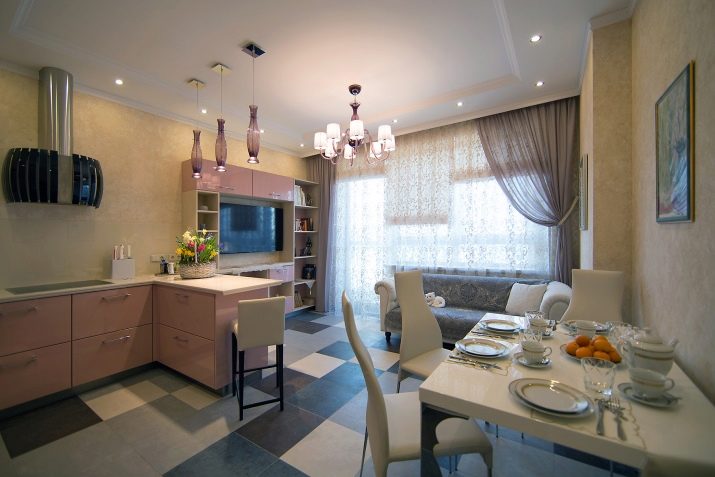

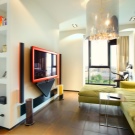



Regardless of what you decide with zoning, furniture must necessarily fit into the overall design of the room.
In crowded conditions, it is desirable that the pieces of furniture do not have sharp corners that can be easily injured, but the owner should be guided by style in order to understand what to give preference to - slightly smoothed corners or their complete absence.
Besides, it is important to correctly fit the furniture into the color scheme of the room... Please note that the colors of the kitchen and living areas may differ, but it is advisable to establish a minimum overlap of shades between them, which can be done, among other things, thanks to the furniture. In the living room, the same armchairs can be a noticeable accent, but in the kitchen everything should overlap with something.
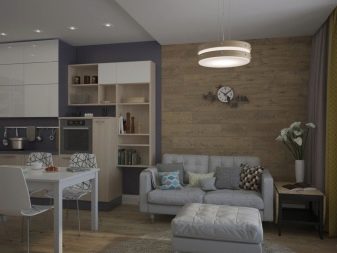
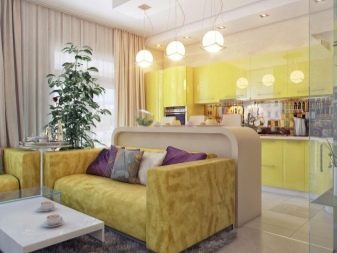


An example of the design of a kitchen-living room in the next video.








